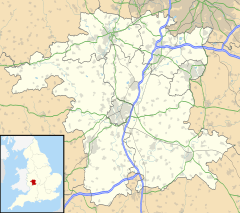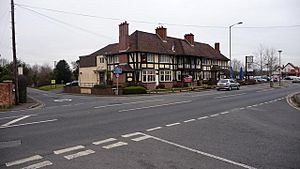Wychbold facts for kids
Quick facts for kids Wychbold |
|
|---|---|
 Church of St Mary de Wyche |
|
| Population | 1,366 (2011 census) |
| OS grid reference | SO922660 |
| Civil parish |
|
| District |
|
| Shire county | |
| Region | |
| Country | England |
| Sovereign state | United Kingdom |
| Post town | DROITWICH |
| Postcode district | WR9 |
| Police | West Mercia |
| Fire | Hereford and Worcester |
| Ambulance | West Midlands |
| EU Parliament | West Midlands |
| UK Parliament |
|
Wychbold is a village located in Worcestershire, England. It sits along the A38 road between the towns of Droitwich Spa and Bromsgrove. The village is also very close to Junction 5 of the M5 motorway, making it easy to reach.
Wychbold is well-known for its large garden centre, Webbs of Wychbold. Early records show that the village was important to the Anglo-Saxons, especially because it was near Droitwich Spa, a place famous for salt.
Contents
- What's in a Name? The Meaning of Wychbold
- A Look Back in Time: Wychbold's History
- How Wychbold is Governed
- Location and People: Geography and Demography
- Local Life: Economy and Transport
- Places of Worship
- Community Services and Education
- Fun and Games: Leisure and Sport
- Famous People from Wychbold
- Images for kids
- See also
What's in a Name? The Meaning of Wychbold
The name Wychbold comes from old English words. Wīc–bold means "Dwelling near the trading settlement."
The name has changed over time. In 692, it was called Uuicbold. By 1086, in the Domesday Book, it was known as Wicelbold. The "wych" part of the name probably refers to Droitwich, which was a busy trading place.
A Look Back in Time: Wychbold's History
People have lived in Wychbold for a very long time. We have found signs of human life from the Iron Age and Roman times.
Ancient Settlements: Iron Age to Roman Times
Archaeologists have discovered old pits, ditches, and postholes in Wychbold. These show that roundhouses once stood here, meaning people had a permanent settlement during the Iron Age.
They also found broken pots and a salt container. This salt container came from Droitwich Spa, and some pottery was from the Malvern Hills. This tells us that even in the Iron Age, Wychbold traded with places far away.
Wychbold is on an old Roman road and a salt road, which is now the A38. Romans likely lived in the area between the 1st and 4th centuries. We know this from the types of pottery found, like Severn Valley and samian pottery.
From Middle Ages to Early Modern Period
The first known mention of Wychbold was in a document from 692. It said that Æthelred of Mercia, a king, gave land there to one of his nobles. This document called the village "distinguished," suggesting it might have belonged to royalty.
Later documents from 815 and 831 also called Wychbold a "royal vill." This means it was an important royal base or even a home for kings. We know an Anglo-Saxon estate existed here, but its exact location is still a mystery.
In the 11th century, a powerful earl named Godwine owned Wychbold. Later, it passed to Osbern fitzRichard. The Domesday Book recorded that Wychbold had 11 "hides" of land (a way to measure land), 5 mills, and 26 salt-making areas. About 50 people lived in the village then.
A manor house, now called Wychbold Court, was built in the Middle Ages. The house you see today was built in the 16th or 17th century. It has a timber-frame style. Digging near the house found pottery from the 13th or 14th century, showing farming was happening there.
There was also another manor house called Wychbold Hall. It was the home of the Amphlett family. Its stone floor was later moved to Greyfriars, Worcester.
Wychbold in the 20th Century
During the Second World War, Wychbold had air raid shelters to protect people from bombs. There was also a concrete blast shelter near the main road. The village's local defense group, the Home Guard, used the Crown Inn as their base.
How Wychbold is Governed
Wychbold is mainly looked after by the Dodderhill Parish Council. This council helps maintain public areas in the village. It is also part of the Wychavon District Council.
For national government, Wychbold is in the Mid Worcestershire area. Its representative in Parliament is Nigel Huddleston.
Location and People: Geography and Demography
Wychbold is located between the towns of Droitwich Spa and Bromsgrove. The River Salwarpe flows around the edge of the village.
Other nearby villages include Upton Warren and Stoke Prior to the north-east, and Rashwood to the south-west. The Droitwich transmitting station, a large radio mast, is just outside the village.
In 2011, Wychbold had 1,366 people living in 586 homes. About 17% of the people were under 16 years old, and 11% were 75 or older. Most of the people (93.1%) were from the White British ethnic group.
In recent years, new housing estates have been built in Wychbold, like Elmbridge Gardens in 2014. More people living in the village has meant that the local school needed to get bigger to fit all the students.
Local Life: Economy and Transport
Wychbold has several places to eat, including a Harvester and a McDonald's. There is also a Holiday Inn hotel near the motorway junction. You can find several petrol stations along the A38.
Webbs of Wychbold is a very popular garden centre just outside the village. It employs many local people. Webbs is famous for its events throughout the year, like a Christmas ice rink, which brings many visitors to Wychbold. You can also find a Hobbycraft and Cotswold Outdoor store inside the garden centre.
The A38 road runs right through Wychbold, connecting it to Droitwich Spa and Bromsgrove. Being near Junction 5 of the M5 motorway makes it easy to travel to bigger cities like Worcester and Birmingham.
The main bus service in Wychbold is the 144, which goes between Worcester and Birmingham. Another bus service, the 145/145A, connects Rubery and Droitwich through Bromsgrove.
Both Droitwich Spa and Bromsgrove have train stations. From there, you can catch trains to Hereford and Birmingham.
Places of Worship
Wychbold's main church is St Mary de Wyche. It is part of the Anglican Diocese of Worcester. This beautiful church was built between 1888 and 1889. Wealthy families and a local Member of Parliament helped pay for it. The church has an old doorway from the late 13th century.
There was also a Congregational church in the village, built in 1836.
Community Services and Education
Wychbold has a local doctor's surgery on De Wyche Road. For emergencies, the closest hospital is Worcestershire Royal Hospital. There are also non-urgent hospitals in Droitwich Spa and Bromsgrove.
Other emergency services are provided by West Mercia Police and Hereford and Worcester Fire and Rescue Service. Both have stations in Droitwich Spa.
The only school in Wychbold is Wychbold First and Nursery School. It opened in September 1972 and teaches children from ages 3 to 10.
Fun and Games: Leisure and Sport
In August 2018, a new play area opened across from Wychbold Village Hall. It has swings, climbing frames, and slides. There are plans to add a small games area for table tennis and boules in the future. The village hall also has football pitches, changing rooms, and a car park.
Wychbold also has a nice walking path called Centurion Way Woods.
After the village's social club closed suddenly in 2017, the people of Wychbold raised over £20,000 to reopen it. The Wychbold Sports and Social Club reopened in July 2017. Its goal is to bring the community together. It has a large lounge, a function room, a small bar, and a snooker room.
Wychbold FC is the village's Sunday league football team. They have played on the pitches outside the village hall for more than 50 years.
Famous People from Wychbold
- George Lashwood (1863–1942) was an English music hall singer. He is buried at St Mary de Wyche church.
Images for kids
See also
 In Spanish: Wychbold para niños
In Spanish: Wychbold para niños




